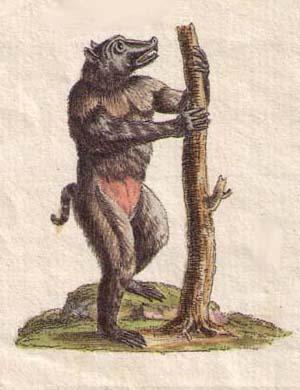 19th century image of a werewolf. (Credit: Copyright Brian Regal)
19th century image of a werewolf. (Credit: Copyright Brian Regal)I love stories of Werewolves. Ever since I was a child and I watched “An American Werewolf in London”, I was instantly drawn to the possibilities of “Were-beings”.
I don’t believe that these creatures ever existed, but when I talked with the prominent researcher of the Wisconsin Werewolf sightings, Linda Godfrey, I ended up with more questions than what I initially had.
It wasn’t until Linda forwarded me a copy of her recent book, “Hunting the American Werewolf” that I really started to question what it was that the people around the Wisconsin area were seeing. Mrs. Godfrey is a skeptic. She never really believed that this creature was out there. Now that she has spent years in the fields and cataloged hundreds of eyewitness accounts with impressive details, there is a different feeling about her skepticism. Like her, I feel like there is something out there in the fields of Wisconsin that people equate to being a Werewolf. What it is, who knows. But more and more people are coming out and testifying seeing this creature years ago.
If we are so inclined to believe in Bigfoot and the Man-Ape evolution or even theorize on Gigantopithecus Blacki a creature that we know existed only for the fact that we found a few teeth and the lower mandible as few as 50 or 60 years ago, then why is it so hard to believe in a Man-Wolf connection? Genetics? Or maybe it’s because science states that human and canine chromosomes do not share similarities?
ScienceDaily (June 16, 2009) — It was Darwinian theory that did away with the werewolf. For much of recorded history, humans have reserved their greatest fears for dog-human hybrids like the werewolf. These beasts were once thought to be real, hiding behind every tree waiting for the unsuspecting traveler.
But, argues Brian Regal, assistant professor of the history of science at Kean University in Union, New Jersey, USA, the publication of Charles Darwin’s On the Origin of Species 150 years ago focused minds on a different kind of monster – ape-men such as the Yeti, Bigfoot and Sasquatch.
Regal will present his thesis in July at the annual meeting of the British Society for the History of Science in Leicester, UK. He will use period artwork to chart the ‘evolution’ of the werewolf into Bigfoot.
From the late 19th century onwards, stories of werewolf encounters tailed away significantly, says Regal. “The spread of the idea of evolution helped kill off the werewolf because a canid-human hybrid makes no sense from an evolutionary point of view,” he says. “The ape-human hybrid, however, is not only evolutionarily acceptable, it is the basis of human evolution.”
Today, in Darwin’s bicentenary year, werewolves have been relegated to films. When it comes to the actual monster scene, it’s Bigfoot that now dominates.
Full source: Science Daily




